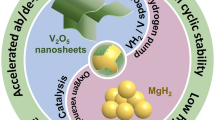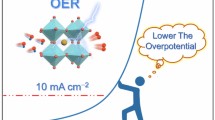Abstract
Two-dimensional (2D) oxide can be continuously produced by bubbling oxygen into liquid metals and the harvesting of these oxide relies on the proper choice of dispersion solvents. The mass-production of ligand-free 2D materials from high melting-point metals will not be possible if the limited stability of the traditional dispersion solvents is not circumvented. Herein, liquid tin was used for the first time in the bubbling protocol and 2D tin oxide was obtained in molten salts. The nanosheets were studied with combined microscopic and spectroscopic techniques, and high-density grain boundaries was identified between the sub-5-nm nano-crystallites in the nanosheets. It gives rise to the high performance in electrocatalytic CO2 reduction reaction. Density-functional-theory based calculation was applied to achieve a deeper understanding of the relationship between the activity, selectivity, and the grain-boundary features. The molten-salt based protocol could be explored for the synthesis of a library of functional 2D oxides.

Similar content being viewed by others
References
Coleman, J. N.; Lotya, M.; O’Neill, A.; Bergin, S. D.; King, P. J.; Khan, U.; Young, K.; Gaucher, A.; De, S.; Smith, R. J. et al. Two-dimensional nanosheets produced by liquid exfoliation of layered materials. Science 2011, 331, 568–571.
Geim, A. K.; Grigorieva, I. V. van der Waals heterostructures. Nature 2013, 499, 419–425.
Bianco, E.; Butler, S.; Jiang, S. S.; Restrepo, O. D.; Windl, W.; Goldberger, J. E. Stability and exfoliation of germanane: A germanium graphane analogue. ACS Nano 2013, 7, 4414–4421.
Park, S.; Ruoff, R. S. Chemical methods for the production of graphenes. Nat. Nanotechnol. 2009, 4, 217–224.
Kim, K. S.; Zhao, Y.; Jang, H.; Lee, S. Y.; Kim, J. M.; Kim, K. S.; Ahn, J. H.; Kim, P.; Choi, J. Y.; Hong, B. H. Large-scale pattern growth of graphene films for stretchable transparent electrodes. Nature 2009, 457, 706–710.
Nicolosi, V.; Chhowalla, M.; Kanatzidis, M. G.; Strano, M. S.; Coleman, J. N. Liquid exfoliation of layered materials. Science 2013, 340, 1226419.
Mei, J.; Liao, T.; Kou, L. Z.; Sun, Z. Q. Two-dimensional metal oxide nanomaterials for next-generation rechargeable batteries. Adv. Mater. 2017, 29, 1700176.
Niu, S. W.; Cai, J. Y.; Wang, G. M. Two-dimensional MOS2 for hydrogen evolution reaction catalysis: The electronic structure regulation. Nano Res. 2020, doi: https://doi.org/10.1007/s12274-020-3249-z.
Chhowalla, M.; Shin, H. S.; Eda, G.; Li, L. J.; Loh, K. P.; Zhang, H. The chemistry of two-dimensional layered transition metal dichalcogenide nanosheets. Nat. Chem. 2013, 5, 263–275.
Zhao, S. Y.; Wang, K.; Zou, X. L.; Gan, L.; Du, H. D.; Xu, C. J.; Kang, F. Y.; Duan, W. H.; Li, J. Group VB transition metal dichalcogenides for oxygen reduction reaction and strain-enhanced activity governed by p-orbital electrons of chalcogen. Nano Res. 2019, 12, 925–930.
Cai, Z. Y.; Bu, X. M.; Wang, P.; Ho, J. C.; Yang, J. H.; Wang, X. Y. Recent advances in layered double hydroxide electrocatalysts for the oxygen evolution reaction. J. Mater. Chem. A 2019, 7, 5069–5089.
Wang, Y. Y.; Yan, D. F.; El Hankari, S.; Zou, Y. Q.; Wang, S. Y. Recent progress on layered double hydroxides and their derivatives for electrocatalytic water splitting. Adv. Sci. 2018, 5, 1800064.
Wu, L. B.; Yu, L.; Xiao, X.; Zhang, F. H.; Song, S. W.; Chen, S.; Ren, Z. F. Recent advances in self-supported layered double hydroxides for oxygen evolution reaction. Research 2020, 2020, 3976278.
Li, F. W.; Chen, L.; Knowles, G. P.; MacFarlane, D. R.; Zhang, J. Hierarchical mesoporous SnO2 nanosheets on carbon cloth: A robust and flexible electrocatalyst for CO2 reduction with high efficiency and selectivity. Angew. Chem., Int. Ed. 2017, 56, 505–509.
Hu, Z. M.; Xiao, X.; Jin, H. Y.; Li, T. Q.; Chen, M.; Liang, Z.; Guo, Z. F.; Li, J.; Wan, J.; Huang, L. et al. Rapid mass production of two-dimensional metal oxides and hydroxides via the molten salts method. Nat. Commun. 2017, 8, 15630.
Jin, H. R.; Hu, Z. M.; Li, T. Q.; Huang, L.; Wan, J.; Xue, G. B.; Zhou, J. Mass production of high-quality transition metal dichalcogenides nanosheets via a molten salt method. Adv. Funct. Mater. 2019, 29, 1900649.
Kalantar-Zadeh, K.; Tang, J. B.; Daeneke, T.; O’Mullane, A. P.; Stewart, L. A.; Liu, J.; Majidi, C.; Ruoff, R. S.; Weiss, P. S.; Dickey, M. D. Emergence of liquid metals in nanotechnology. ACS Nano 2019, 13, 7388–7395.
Zavabeti, A.; Ou, J. Z.; Carey, B. J.; Syed, N.; Orrell-Trigg, R.; Mayes, E. L. H.; Xu, C. L.; Kavehei, O.; O’Mullane, A. P.; Kaner, R. B. et al. A liquid metal reaction environment for the room-temperature synthesis of atomically thin metal oxides. Science 2017, 358, 332–335.
Alkathiri, T.; Dhar, N.; Jannat, A.; Syed, N.; Mohiuddin, M.; Alsaif, M. M. Y. A.; Datta, R. S.; Messalea, K. A.; Zhang, B. Y.; Khan, M. W. et al. Atomically thin TiO2 nanosheets synthesized using liquid metal chemistry. Chem. Commun. 2020, 56, 4914–4917.
Zavabeti, A.; Zhang, B. Y.; de Castro, I. A.; Ou, J. Z.; Carey, B. J.; Mohiuddin, M.; Datta, R.; Xu, C. L.; Mouritz, A. P.; McConville, C. F. et al. Green synthesis of low-dimensional aluminum oxide hydroxide and oxide using liquid metal reaction media: Ultrahigh flux membranes. Adv. Funct. Mater. 2018, 28, 1804057.
Ju, M.; Liang, X. Y.; Liu, J. X.; Zhou, L.; Liu, Z.; Mendes, R. G.; Rümmeli, M. H.; Fu, L. Universal substrate-trapping strategy to grow strictly monolayer transition metal dichalcogenides crystals. Chem. Mater. 2017, 29, 6095–6103.
Zeng, M. Q.; Fu, L. Controllable fabrication of graphene and related two-dimensional materials on liquid metals via chemical vapor deposition. Acc. Chem. Res. 2018, 51, 2839–2847.
Yuan, T. B.; Hu, Z.; Zhao, Y. X.; Fang, J. J.; Lv, J.; Zhang, Q. H.; Zhuang, Z. B.; Gu, L.; Hu, S. Two-dimensional amorphous SnOx from liquid metal: Mass production, phase transfer, and electrocatalytic CO2 reduction toward formic acid. Nano Lett. 2020, 20, 2916–2922.
Zhdanov, V. P.; Kasemo, B. Cabrera-Mott kinetics of oxidation of nm-sized metal particles. Chem. Phys. Lett. 2008, 452, 285–288.
Li, S.; Qin, F.; Peng, Q.; Liu, S.; Zhang, Z. H.; Zhang, D. Y.; Liu, C.; Li, D. Y.; Liu, J. L.; Qi, J. H. et al. van der Waals mixed valence tin oxides for perovskite solar cells as UV-stable electron transport materials. Nano Lett. 2020, 20, 8178–8184.
Daeneke, T.; Atkin, P.; Orrell-Trigg, R.; Zavabeti, A.; Ahmed, T.; Walia, S.; Liu, M. N.; Tachibana, Y.; Javaid, M.; Greentree, A. D. et al. Wafer-scale synthesis of semiconducting SnO monolayers from interfacial oxide layers of metallic liquid tin. ACS Nano 2017, 11, 10974–10983.
Wu, J.; Bai, X.; Ren, Z. Y.; Du, S. C.; Song, Z. H.; Zhao, L.; Liu, B. W.; Wang, G. L.; Fu, H. Multivalent Sn species synergistically favours the CO2-into-HCOOH conversion. Nano Res. 2021, 14, 1053–1060.
Wu, J.; Xie, Y.; Du, S. C.; Ren, Z. Y.; Yu, P.; Wang, X.W.; Wang, G. L.; Fu, H. G. Heterophase engineering of SnO2/Sn3O4 drives enhanced carbon dioxide electrocatalytic reduction to formic acid. Sci. China Mater. 2020, 63, 2314–2324.
Liu, S. B.; Xiao, J.; Lu, X. F.; Wang, J.; Wang, X.; Lou, X. W. Efficient electrochemical reduction of CO2 to HCOOH over Sub-2 nm SnO2 quantum wires with exposed grain boundaries. Angew. Chem., Int. Ed. 2019, 58, 8499–8503.
Gu, J.; Héroguel, F.; Luterbacher, J.; Hu, X. L. Densely packed, ultra small SnO nanoparticles for enhanced activity and selectivity in electrochemical CO2 reduction. Angew. Chem., Int. Ed. 2018, 57, 2943–2947.
Zhang, M.; Hu, Z.; Gu, L.; Zhang, Q. H.; Zhang, L. H.; Song, Q.; Zhou, W.; Hu, S. Electrochemical conversion of CO2 to syngas with a wide range of CO/H2 ratio over Ni/Fe binary single-atom catalysts. Nano Res. 2020, 13, 3206–3211.
Chen, Z.; Fan, T. T.; Zhang, Y. Q.; Xiao, J.; Gao, M. R.; Duan, N. Q.; Zhang, J. W.; Li, J. H.; Liu, Q. X.; Yi, X. D. et al. Wavy SnO2 catalyzed simultaneous reinforcement of carbon dioxide adsorption and activation towards electrochemical conversion of CO2 to HCOOH. Appl. Catal. B Environ. 2020, 261, 118243.
Cai, Z.; Zhang, Y. S.; Zhao, Y. X.; Wu, Y. S.; Xu, W. W.; Wen, X. M.; Zhong, Y.; Zhang, Y.; Liu, W.; Wang, H. L. et al. Selectivity regulation of CO2 electroreduction through contact interface engineering on superwetting Cu nanoarray electrodes. Nano Res. 2019, 12, 345–349.
Xiao, X.; Song, H. B.; Lin, S. Z.; Zhou, Y.; Zhan, X. J.; Hu, Z. M.; Zhang, Q.; Sun, J. Y.; Yang, B.; Li, T. Q. et al. Scalable salt-templated synthesis of two-dimensional transition metal oxides. Nat. Commun. 2016, 7, 11296.
Huang, L.; Hu, Z. M.; Jin, H. R.; Wu, J. B.; Liu, K. S.; Xu, Z. H.; Wan, J.; Zhou, H.; Duan, J. J.; Hu, B. et al. Salt-assisted synthesis of 2D materials. Adv. Funct. Mater. 2020, 30, 1908486.
Acknowledgements
This work was financially supported by the Natural Science Foundation of Tianjin, China (No. 18JCYBJC20600) and Institute of Energy, Hefei Comprehensive National Science Center (No. 19KZS207), the National Natural Science Foundation of China (Nos. 62074123, 61701543, and 21701168), the PetroChina Innovation Foundation (No. 2019D-5007-0410), the National Key R&D Program of China (No. 2020YFA0406100), Dalian high level talent innovation project (No. 2019RQ063). We gratefully acknowledge BL14W1 beamline of Shanghai Synchrotron Radiation Facility (SSRF) Shanghai, China for providing the beam time. Many thanks for the technical support from Instrument Analysis Center of Xi’an Jiaotong University.
Author information
Authors and Affiliations
Corresponding authors
Electronic Supplementary Material
Rights and permissions
About this article
Cite this article
Hu, Z., Yuan, T., Li, H. et al. Two-dimensional oxide derived from high-temperature liquid metals via bubble templating. Nano Res. 14, 4795–4801 (2021). https://doi.org/10.1007/s12274-021-3430-z
Received:
Revised:
Accepted:
Published:
Issue Date:
DOI: https://doi.org/10.1007/s12274-021-3430-z




